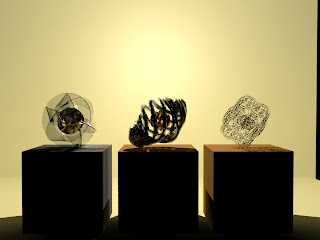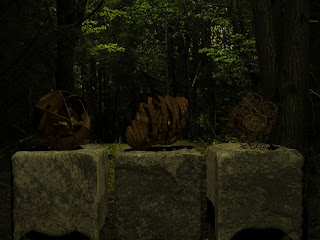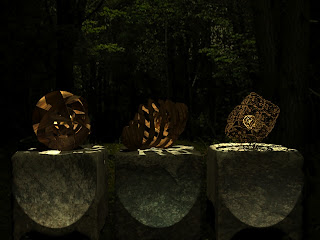I decided I wanted my renders to be of the same theme as my photograph, so I endeavored to have a render setup that mirrored the photo, but with 3 models.
I set my models up so that were all on their own individual pedestals, and set in a natural environment, and played with lighting and textures for each
 |
| Glass and Copper texture trial |
Here I wanted to trial the Glass textures to see if they would suit my models, and have the internals of the models as copper so that I could test the reflective and refractive qualities of each. Unfortunately the glass texture did not suit my main model well, as it ended up with total internal reflection causing the model to go black.
 |
| Wood and Stone texture trial |
Here I tested the stone texture I had on the pedestals to see whether it would be suitable, which I was quite pleased with - I just needed to work on the UVW mapping so that it was uniform with no edges. I also applied a wooden texture to all my models, which I felt worked really well and would provide a good surface to play with lighting effects. Ideally I wanted a semi-transparent texture to show off the internals of each, but I felt wood would be a more natural texture to go with my narrative, and lighting could be used to achieve the same effect.
 |
| Background texture trial |
I really wanted my models to be in a natural environment, so I tested using this forest scene as a background for my render, which I feel worked very well. I found that it was near impossible to modify lighting effects of the forest scene, so I did these in Photoshop before importing them into 3DS Max.
 |
| Coloured lighting trial |
I tested using coloured lighting to see whether it would provide a more natural aesthetic to the scene, and I went with a yellow-green type colour as it might be filtered through a leaf, say. I was not particularly pleased with the effect, as it tinted everything to a strange tone which detracted from my models.
 |
| Volumetric lighting trial |
I tested using volumetric lighting to better present the models exterior, though I found that it looked both unnatural and detracted away from the internal space of the models, which is something I wanted to showcase.
 |
| Spotlighting and Internal Omni lighting trial |
Here I put spotlighting on the models, both as a presentation aesthetic as it might be seen in a museum, but also to differentiate between the final model and the other two models. I was pleased with the effect.
 |
| Omni lighting and 1080p cropping trial |
Here is the final image, with changes to the Omni lighting for the scene which darkened the background to both make it look like a dusk scene, but also to strengthen the lighting effects of the spotlights and the internal Omni lights.























































